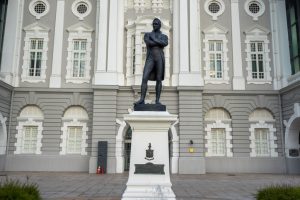Against the Grain: Raffles in the Age of Fallen Heroes
July 29, 2020

On 25 May 2020, a Minneapolis police officer knelt on the neck of George Floyd for over eight minutes, and killed him. Following Floyd’s death, a series of protests erupted and continues being held to advance the Black Lives Matter cause against racism. Underpinning these protests are anti-colonial sentiments that emerged in the late colonial period, expressed with a renewed vigour as ‘new’ decolonial politics. Such politics are aimed at overthrowing colonisers regarded as symbols of colonial oppression and racism, and yet are still featured as dominant, proud, and canonized.
However, Singapore presents a unique case that goes against the grain. In ‘Against the grain: Raffles in the age of fallen heroes’, Professor Syed Farid Alatas (NUS Departments of Sociology and Malay Studies) discusses how Sir Stamford Raffles is one of the rare instances in history of a colonial administrator serving as a national icon. This is contrary to the approaches of most post-colonial nations, whose views are extremely critical towards colonialism and the colonial figures who ruled over them. For instance, the Black Lives Matter movement has undertaken the politics of ‘toppling’, in which statues of colonisers are toppled to symbolise change. These statues include Cecil John Rhodes, the British mining magnate and coloniser of Africa, and Edward Colston, English merchant and slave trader. Put into context, these protests serve as a continuing critique of the legacies of apartheid and colonisation.
Yet the same cannot be said in Singapore’s case. Sir Stamford Raffles remains seen as a national hero, even though the context of colonial oppression and racism manifests itself likewise in the form of British imperialism. Prof Alatas points out the ethnic bias of British historians and biographers in their presentation of Raffles. They neglected a critical treatment of Raffles’ colonial racism and corruption in order to present him as a progressive statesman and humanitarian reformer.
Raffles’ ethnically prejudiced views of Asian communities were understated and dismissed from scrutiny. For example, Raffles regarded the Malays as rude, uncivilised, and intellectually feeble, amongst other things. Prof Alatas mentions that Raffles was involved in the Massacre of Palembang, which resulted in the murders of 24 Europeans and 63 Javanese soldiers and civilians. Also, Raffles used forced labour and corruption to acquire a territory along the Borneo coast, and supported the opium trade that landed him profitable commissions.
Today, Raffles’ name lives on in many forms which include two statues, landmark buildings, businesses, educational institutions, and the world’s largest flower, the Rafflesia. Although Singapore celebrates Raffles as its founder, Prof Alatas warns that colonialism was not only about political-economic control and rule. He states that colonialism was responsible for the physical and cultural devastation of livelihoods, and we should thus reconsider its meaning. While Raffles was a product of his time and social context, this does not permit the erasure of injustices brought upon the people under his rule.
Read the full article here.
